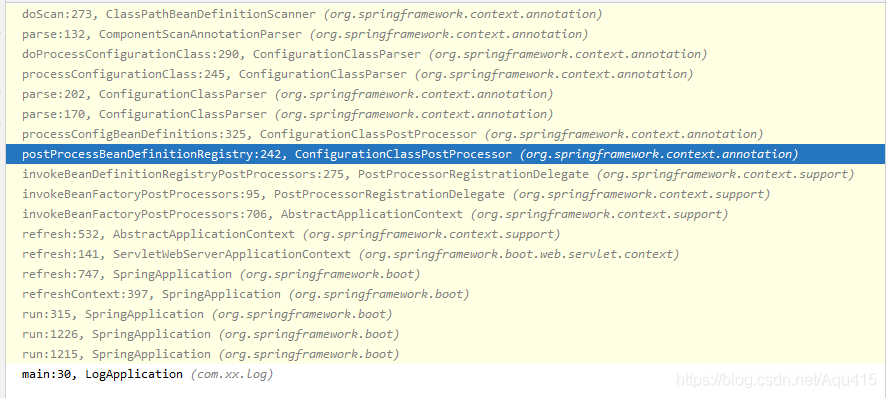使用Springboot怎么对路径进行扫描?相信很多没有经验的人对此束手无策,为此本文总结了问题出现的原因和解决方法,通过这篇文章希望你能解决这个问题。
我们暂且标注下Springboot启动过程中较为重要的逻辑方法,源码对应的spring-boot-2.2.2.RELEASE版本
public ConfigurableApplicationContext run(String... args) {
StopWatch stopWatch = new StopWatch();
stopWatch.start();
ConfigurableApplicationContext context = null;
Collection<SpringBootExceptionReporter> exceptionReporters = new ArrayList<>();
configureHeadlessProperty();
SpringApplicationRunListeners listeners = getRunListeners(args);
listeners.starting();
try {
ApplicationArguments applicationArguments = new DefaultApplicationArguments(args);
ConfigurableEnvironment environment = prepareEnvironment(listeners, applicationArguments);
configureIgnoreBeanInfo(environment);
Banner printedBanner = printBanner(environment);
//@A
context = createApplicationContext();
exceptionReporters = getSpringFactoriesInstances(SpringBootExceptionReporter.class,
new Class[] { ConfigurableApplicationContext.class }, context);
//@B
prepareContext(context, environment, listeners, applicationArguments, printedBanner);
//@C
refreshContext(context);
afterRefresh(context, applicationArguments);
stopWatch.stop();
if (this.logStartupInfo) {
new StartupInfoLogger(this.mainApplicationClass).logStarted(getApplicationLog(), stopWatch);
}
listeners.started(context);
callRunners(context, applicationArguments);
}
catch (Throwable ex) {
handleRunFailure(context, ex, exceptionReporters, listeners);
throw new IllegalStateException(ex);
}
try {
listeners.running(context);
}
catch (Throwable ex) {
handleRunFailure(context, ex, exceptionReporters, null);
throw new IllegalStateException(ex);
}
return context;
}第一步:ConfigurationClassPostProcessor注入
org.springframework.context.annotation.ConfigurationClassPostProcessor是一个BeanDefinitionRegistryPostProcessor(父类是BeanFactoryPostProcessor),会在容器初始化好并装载完第一阶段的bean定义后调用,我理解的其主要作用是执行一些框架内部方法也让用户自定义再次注入自定义的bean定义;
它的注册是在SpringApplication.run方法调用后,具体调用链是
org.springframework.boot.SpringApplication#run(java.lang.Class<?>, java.lang.String...) ->org.springframework.boot.SpringApplication#run(java.lang.String...) ->org.springframework.boot.SpringApplication#createApplicationContext //对应上面@A标注的地方 //后续会初始化一个org.springframework.boot.web.servlet.context.AnnotationConfigServletWebServerApplicationContext对象,在构造方法里会执行一系列的逻辑 ->org.springframework.context.annotation.AnnotatedBeanDefinitionReader#AnnotatedBeanDefinitionReader(org.springframework.beans.factory.support.BeanDefinitionRegistry) ->org.springframework.context.annotation.AnnotatedBeanDefinitionReader#AnnotatedBeanDefinitionReader(org.springframework.beans.factory.support.BeanDefinitionRegistry, org.springframework.core.env.Environment) ->org.springframework.context.annotation.AnnotationConfigUtils#registerAnnotationConfigProcessors(org.springframework.beans.factory.support.BeanDefinitionRegistry) ->org.springframework.context.annotation.AnnotationConfigUtils#registerAnnotationConfigProcessors(org.springframework.beans.factory.support.BeanDefinitionRegistry, java.lang.Object) //这个方法会注入5个bean定义: 1. ConfigurationClassPostProcessor.class 2. AutowiredAnnotationBeanPostProcessor.class 3. CommonAnnotationBeanPostProcessor.class 4. EventListenerMethodProcessor.class 5. DefaultEventListenerFactory.class
第二步:启动类bean定义注入
被我们标记了@SpringBootApplication的类在运行过程中会被包装成一个bean定义,放入容器中;具体方法调用链
org.springframework.boot.SpringApplication#run(java.lang.String...) org.springframework.boot.SpringApplication#prepareContext //对应上面代码标注 @B 的地方 org.springframework.boot.SpringApplication#load org.springframework.boot.BeanDefinitionLoader#load(java.lang.Object) org.springframework.boot.BeanDefinitionLoader#load(java.lang.Class<?>) org.springframework.context.annotation.AnnotatedBeanDefinitionReader#register org.springframework.context.annotation.AnnotatedBeanDefinitionReader#registerBean(java.lang.Class<?>) org.springframework.context.annotation.AnnotatedBeanDefinitionReader#doRegisterBean //里面一段代码 如下: AnnotatedGenericBeanDefinition abd = new AnnotatedGenericBeanDefinition(beanClass); //从这个方法里可以看出,启动类被包装成了 AnnotatedGenericBeanDefinition(实现了AnnotatedBeanDefinition接口,这很重要)
第三步:解析包扫描信息并完成剩余bean注册
刚刚在第一步里,容器中注入了ConfigurationClassPostProcessor后置处理器,后置处理器会在核心方法refresh中执行,也就是上面标注@C的代码里;
我们直接来到核心逻辑处,调用链:

由于第二步容器中将启动类包装成AnnotatedGenericBeanDefinition并注入了容器,在方法
org.springframework.context.annotation.ConfigurationClassParser#parse(java.util.Set<org.springframework.beans.factory.config.BeanDefinitionHolder>)会被处理执行后续的包扫描
看完上述内容,你们掌握使用Springboot怎么对路径进行扫描的方法了吗?如果还想学到更多技能或想了解更多相关内容,欢迎关注亿速云行业资讯频道,感谢各位的阅读!
免责声明:本站发布的内容(图片、视频和文字)以原创、转载和分享为主,文章观点不代表本网站立场,如果涉及侵权请联系站长邮箱:is@yisu.com进行举报,并提供相关证据,一经查实,将立刻删除涉嫌侵权内容。